Marketing automation workflows have become the backbone of digital marketing automation strategy. We don’t like repeating ourselves, but when companies make $5.44* for every $1 they spend on email marketing automation, translating to an ROI of 444%—it’s difficult not to.
With businesses seeking efficiency and personalization at scale, understanding how to automate marketing workflows that help drive customer retention is crucial for staying on the competition ladder in 2025’s always-changing marketing landscape.
What is Marketing Automation Workflow
Marketing workflow automation is a series of automated actions, such as joining a subscriber’s list or buying a product, triggered by specific user behaviors. Think of it as a personal assistant who manages marketing processes and knows exactly when and how to act in different scenarios.
Our favorite thing about email automation workflows? You don’t have to answer and respond to different actions by hand.
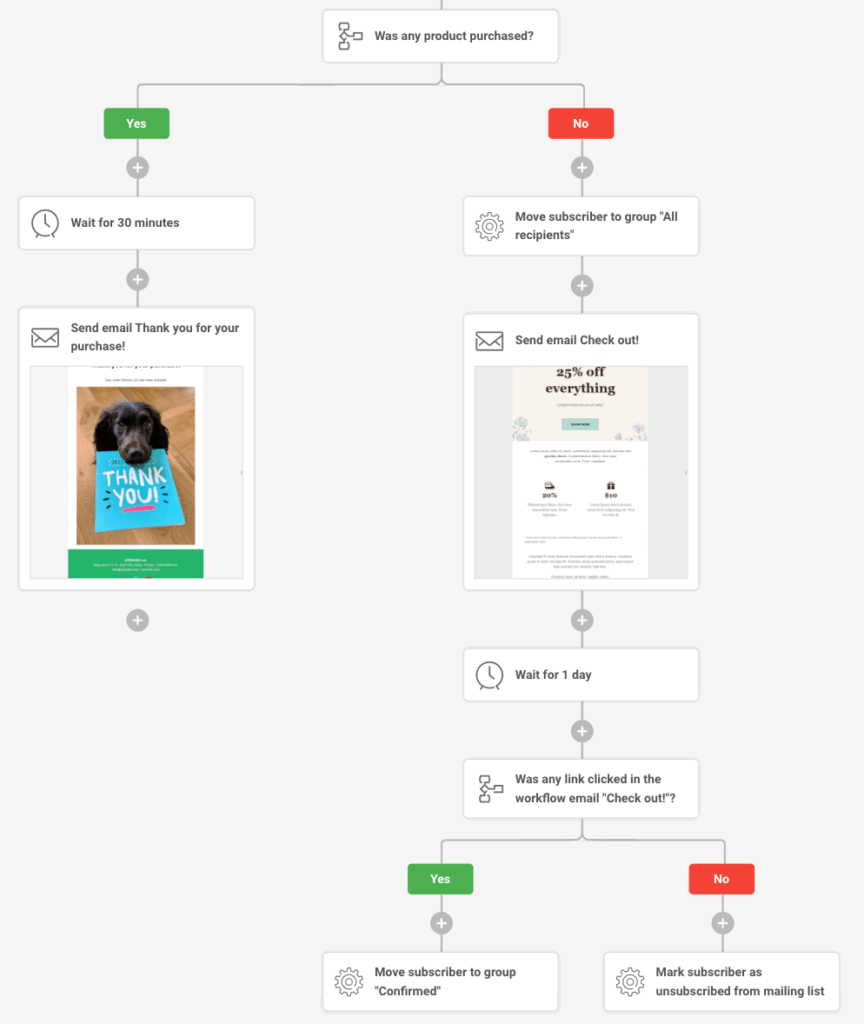
From sending welcome emails to nurturing leads and launching drip campaigns, automation workflows eliminate time consuming marketing tasks while delivering timely, relevant content to your target audience at the right time.
Benefits of Marketing Automation Workflow
- Save time & increase efficiency. Companies can save up to 5-10 hours each week by automating only 15-20 emails. Automation, especially when paired with reliable bulk email services, eliminates repetitive tasks, allowing teams to focus on strategic initiatives, complex automations and multifunctional campaigns.
- Improve lead nurturing and conversion. Companies that excel at lead nurturing generate 50% more sales-ready leads at 33% lower cost per lead, while nurtured leads make 47%* larger purchases than non-nurtured leads. Where automated marketing workflows come into play is ensuring consistent and personalized touchpoints that guide prospects through a strategic sales funnel.
- Delivers personalized customer experiences. Personalized emails generate 6x higher transaction rates* compared to non-personalized versions. Moreso, personalized email campaigns achieve 29% higher open rates and 41% higher click-through rates when supported by automated customer journeys.
- Generates better quality leads. Organizations that use marketing automation with prospects experience a 451% increase in qualified leads, while 80% of marketers using marketing automation software manage to generate more leads than competitors who don’t.
- Provides data-driven insights. Most email marketing services that use automation track user behavior, campaign performance, and engagement metrics in real time, giving teams a clear view of what’s working and what’s not.
- Solves critical marketing challenges. From reducing manual workload to improving targeting accuracy, marketing automation solves bottlenecks that slow teams down.
Marketing automation is easy with Sender. Use features like drag-and-drop email builder, automation, and segmentation—all completely free!
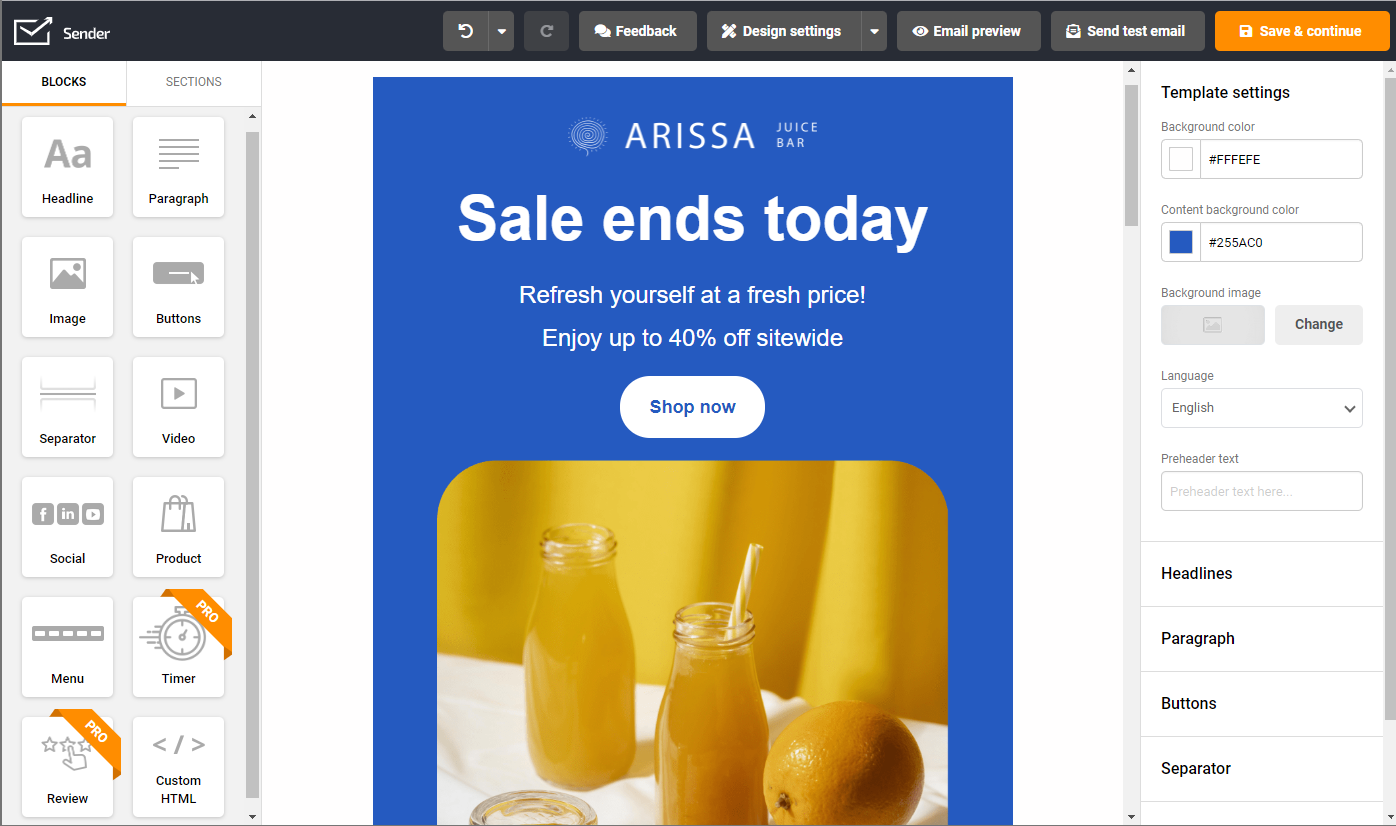
13 Marketing Automation Workflow Examples
Each marketing automation example on this list presents how you can save hundreds of man-hours, personalize and increase conversions in different parts of the customer journey by employing email marketing automation tools.
1. Welcome Email Series
Welcome email sequences serve as your brand’s digital handshake, creating lasting first impressions that determine long-term subscriber engagement. User activation automation triggers when they subscribe to your newsletter, create an account, or download gated content.
One thing to remember is that an automated ‘welcome’ email should occur within minutes of form submission, whether through website opt-ins, lead magnets, or account registrations on your marketing automation platform.
Trigger: Person subscribes to a newsletter
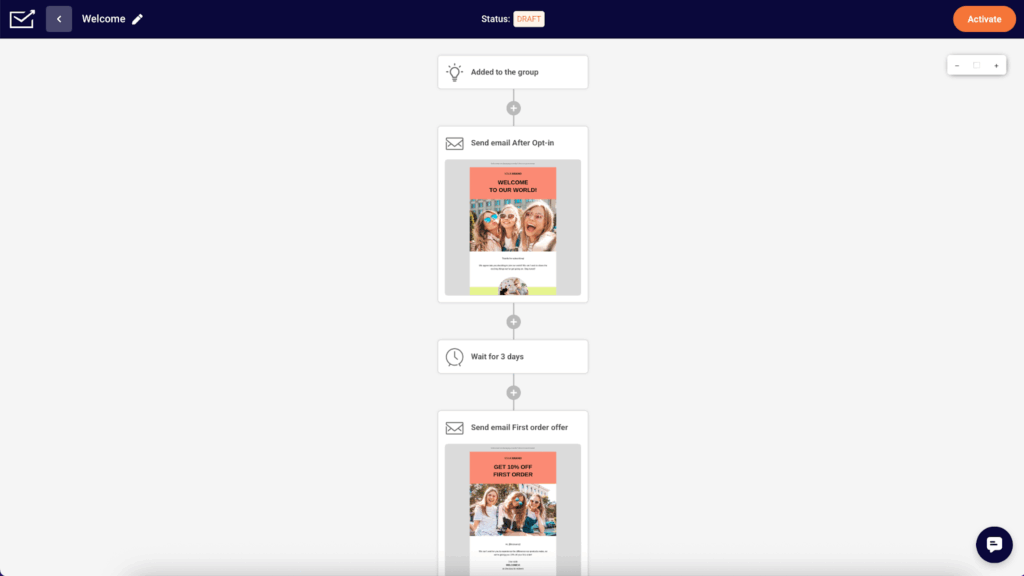
The optimal welcome series spans 3-5 strategically timed emails over 7-14 days, beginning with an immediate confirmation that validates the subscription and sets clear expectations. The sequence progresses through brand storytelling, valuable resource sharing, and gentle product introductions while maintaining consistent messaging across all touchpoints.
- Technical implementation. Modern marketing automation tools like HubSpot and Mailchimp offer drag-and-drop builders for creating sophisticated welcome sequences. Advanced segmentation allows customization based on subscriber source, demographic data, or expressed interests.
- Performance optimization. Optimized welcome email campaigns can achieve 68.6%* open rates and 15-25% click-through rates. A/B testing subject lines, send times, and content formats helps optimize engagement metrics. Track progression through the entire sequence to identify drop-off points and refine messaging accordingly.
- Content strategy. Include exclusive offers for new subscribers (helpful resources like guides or access to pre-made templates is always a good call) and clear CTAs directing toward your primary conversion goals.
2. Abandoned Cart Recovery
Abandoned cart workflow is one of the foundational automation examples, addressing one of ecommerce’s most persistent challenges—targeting almost 70%* of online shoppers (or 3 out of 4 people) who add items to their online shopping cart but leave without completing their purchase.
The good news is that a fine-tuned automated email sequence can gently remind these customers to complete their purchase, increasing the chances of recovery.
Through strategic follow-up emails, it’s possible to recover 10-15%* of abandoned sales.
Ideally, you should set up a trigger that activates when customers add products to their cart but fail to complete checkout within a predetermined timeframe, typically within 30 minutes and up to 1 hour.
Trigger: Customer adds product to their cart and leaves the site without completing checkout
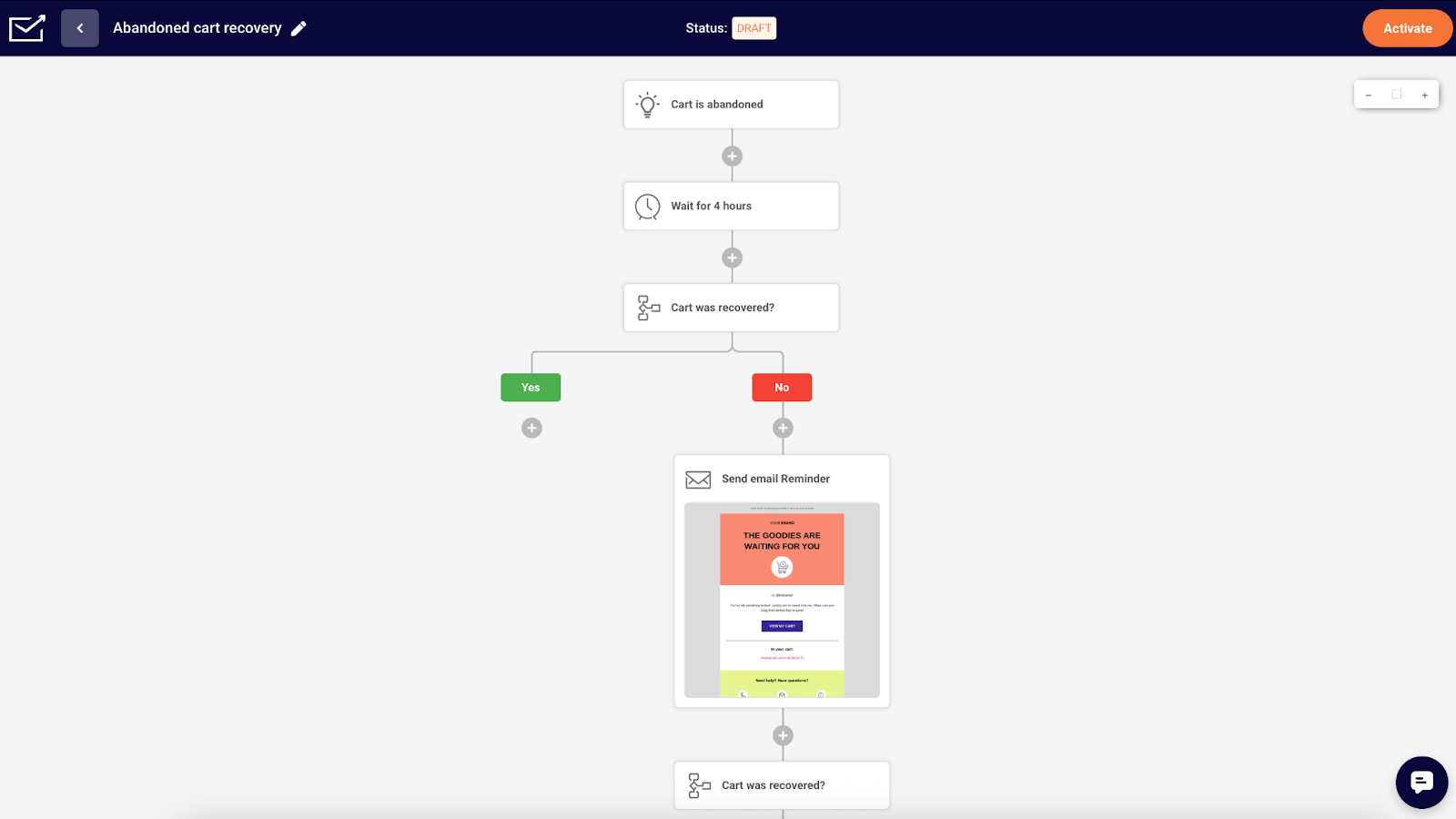
The three-email sequence begins with an immediate reminder within 1-2 hours, showcasing the specific abandoned products with compelling visuals and clear purchase links. The second email arrives after 24 hours, incorporating social proof through customer reviews, testimonials, or purchase notifications to build confidence and address potential objections.
- Advanced personalization. Leverage browsing history and purchase patterns to include product suggestions or highlight limited inventory to create FOMO. Dynamic content insertion displays exact product images, descriptions, and pricing from the abandoned cart.
- Incentive strategy. The final email, sent 3-7 days later, introduces progressive incentives like free shipping, discounts, or limited-time offers. Avoid leading with discounts in initial emails to maintain profit margins while testing different incentive structures to optimize conversion rates.
- Cross-channel integration. Extend recovery efforts beyond email through retargeting digital ads on social media platforms and display networks. Coordinate messaging across channels to reinforce the abandoned cart reminder while avoiding customer fatigue.
3. Lead Nurturing Workflow
Lead nurturing workflows transform initial interest into sales-ready prospects, guiding them through key stages of the customer lifecycle with strategic content delivery and relationship building. Instead of shoving them straight into the gift shop, you walk them through the sights, answer their questions, and give them just the right info at the right time.
That said, here’s a snack-sized lead scoring methodology if you’re completely new to lead scoring:
- Point-based scoring. Assigning a numerical value to each lead attribute and determining the threshold based on the accumulated score and past lead qualification history;
- Scoring tiers. Grouping leads into different categories or tiers based on their scores and defining the threshold for each tier;
- Qualification criteria. Setting specific requirements or conditions that a lead must meet to cross the scoring threshold;
- Historical conversion data. Analyzing historical data to determine the score range that has resulted in successful conversions;
- A/B testing. Experimenting with different scoring thresholds and measuring the impact on conversion rates to optimize the threshold value.
You should trigger a lead nurturing campaign when prospects download lead magnets, attend webinars, request product demos, or demonstrate specific behavioral patterns indicating their interest in one of your products.
Trigger: User submits lead generation form
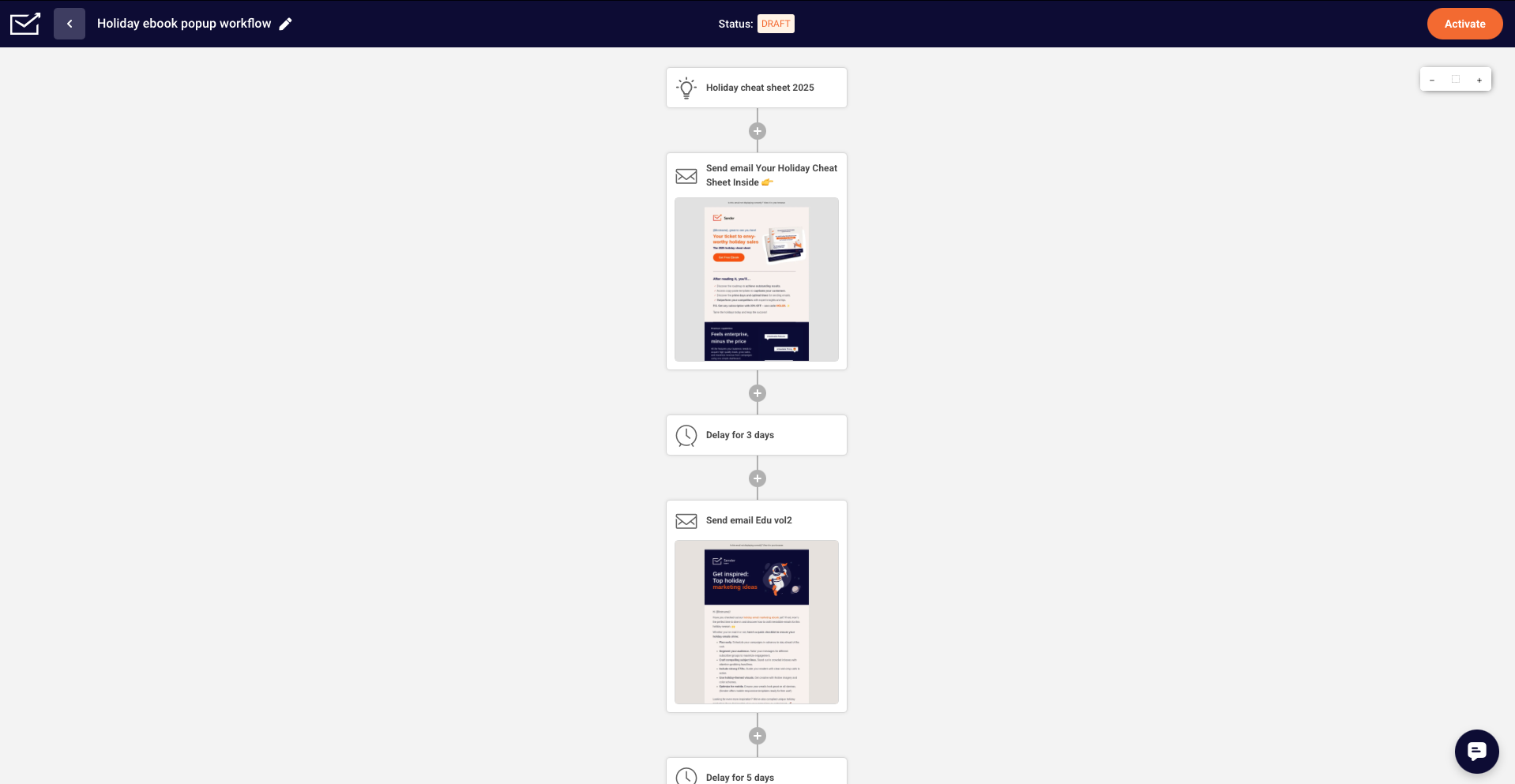
The multi-email nurturing campaign typically spans 4-8 weeks, nurturing the prospect until they take the action you’re aiming for (whether that’s a sale or opting for a subscription). The goal is to nudge them forward with each touchpoint using timely follow-up communications, while keeping the conversation warm and engaging.
- Segmentation strategy. Advanced lead scoring automation will assign point values to various prospect behaviors, enabling dynamic content delivery based on engagement levels and demographic characteristics. Segment potential customers by industry, company size, role, or expressed interests to ensure maximum relevance and engagement.
- Sales integration. Implement lead scoring thresholds that automatically notify sales teams when prospects reach sales-ready status. Provide sales reps with detailed engagement histories and browsing patterns to enable informed and personalized messages.
- Performance measurement. Track email engagement metrics, content downloads, website behavior, and ultimate conversion rates to optimize sequence timing, content selection, and messaging approaches for maximum lead-to-customer conversion efficiency.
4. Order Confirmation Workflow
Order confirmation campaigns extend far beyond basic transaction receipts that build customer confidence and encourage repeat purchases. It’s a window to turn a one-time customer into a loyal one.
Along with welcome emails, order confirmation campaigns are the bread and butter of email marketing, having the highest open rate of all transactional emails—up to a stunning 70%*.
Order confirmation campaigns should trigger immediately upon successful payment processing, sending confirmation within minutes of completed transactions to reassure customers about their purchase.
Trigger: Customer completes transaction
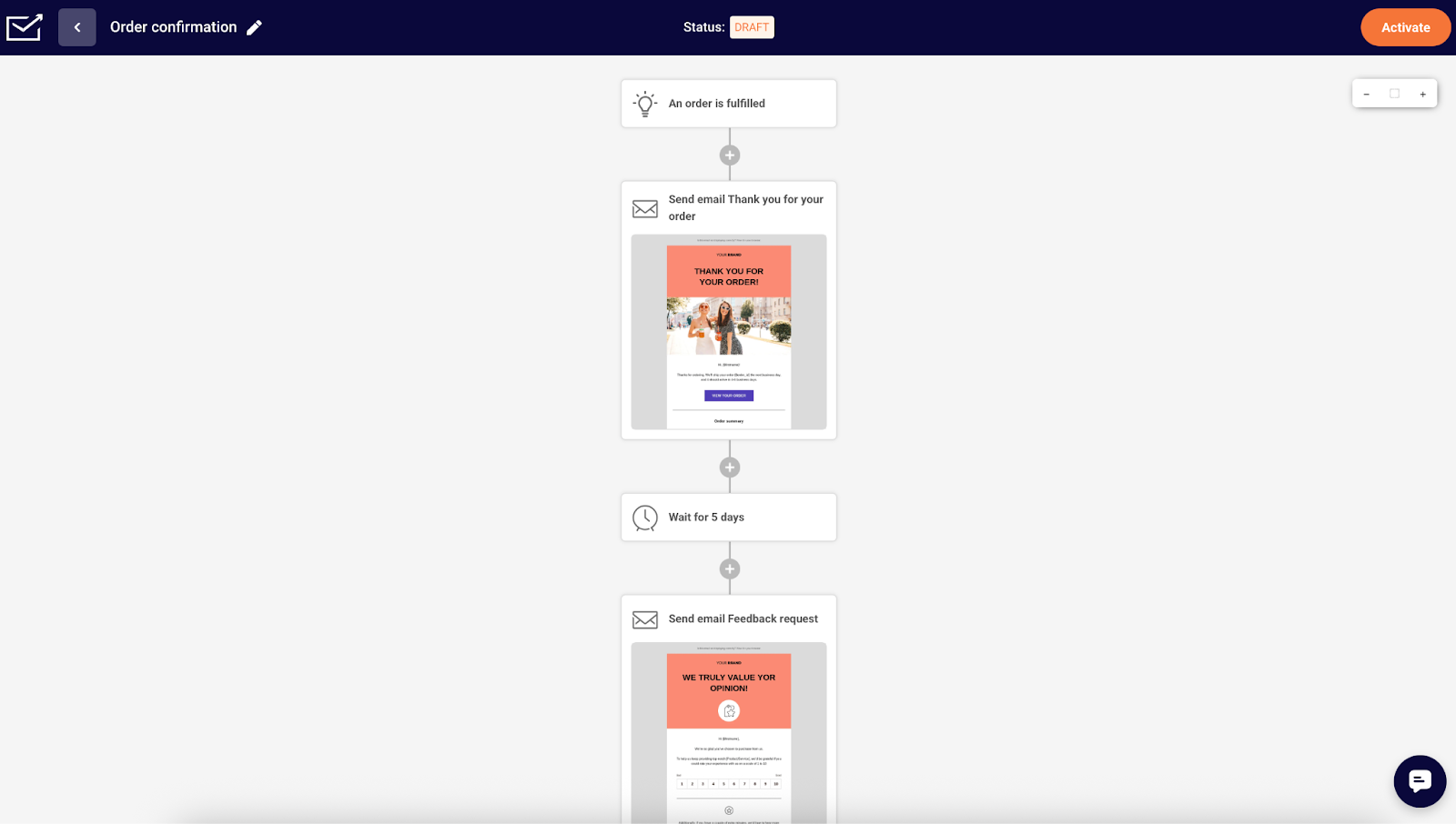
The comprehensive order confirmation email includes immediate purchase confirmation with detailed order summaries, shipping notifications with tracking information, delivery updates with estimated arrival times, and customer support contact information.
- Value-added content. Transform transactional messages into valuable communications by including product care instructions, usage tips, styling suggestions, or exclusive content related to purchased items.
- Cross-selling opportunities. Strategically introduce complementary products or accessories that enhance the original purchase experience. Time these suggestions appropriately.
- Customer service integration. Provide multiple contact channels, comprehensive FAQ sections, and proactive support resources to address potential concerns before they become problems. Include dedicated customer service contacts.
- Loyalty program integration. Use confirmation emails to introduce loyalty programs, referral incentives, or exclusive member benefits that encourage future engagement. Highlight points earned, reward levels achieved, or special status unlocked through the current purchase.
5. Re-engagement Campaign
Re-engagement workflows serve as your final opportunity to revive inactive subscribers before list removal, attempting to rekindle relationships with inactive contacts who haven’t engaged with your content for an extended period of time.
These campaigns help maintain list hygiene by automating marketing tasks that would otherwise take hours of manual labor, potentially recovering valuable subscribers. The good news is that re-engagement campaigns have a 10-20% winback rate on lapsed users.
Re-engagement campaigns should set off when subscribers haven’t opened emails or engaged with content for 60-90 days, indicating declining interest or potential deliverability issues.
Trigger: User makes no page visits in 90 days

The strategic 2-4 email sequence begins with gentle attempts at customer engagement, starting with a gentle “we miss you” messaging, and concluding with clear unsubscribe options to maintain list quality and sender reputation.
- Subject line testing. Experiment with curiosity-driven subject lines like “We miss you,” “One last email,” or “Is this goodbye?” to capture attention and encourage opens. Test personalized approaches versus generic messaging. If you need more inspiration, head to our re-engagement campaign subject line guide.
- Content strategy. Offer exclusive content previews, significant discounts, or early access to new products as incentives for re-engagement. Survey inactive subscribers about content preferences, sending frequency, or topic interests to understand disengagement reasons.
- List segmentation. Create separate segments for different inactivity periods, allowing customized messaging based on engagement history. Recent inactive subscribers might receive different content than those dormant for extended periods (say 120 days).
6. Birthday Email Campaign
Birthday campaigns are all about joining the celebration—making customers feel special while giving them a well-timed, personalized offer that also gives your sales a nice little boost. The best kind of win-win scenario.
These highly engaging workflows achieve above-average open rates (ranging from 45% to 65%*) due to their personal nature and exclusive offers—it’s you telling subscribers that you remember. And what’s more effective than that?
Trigger: User’s birthday (today or in X days)
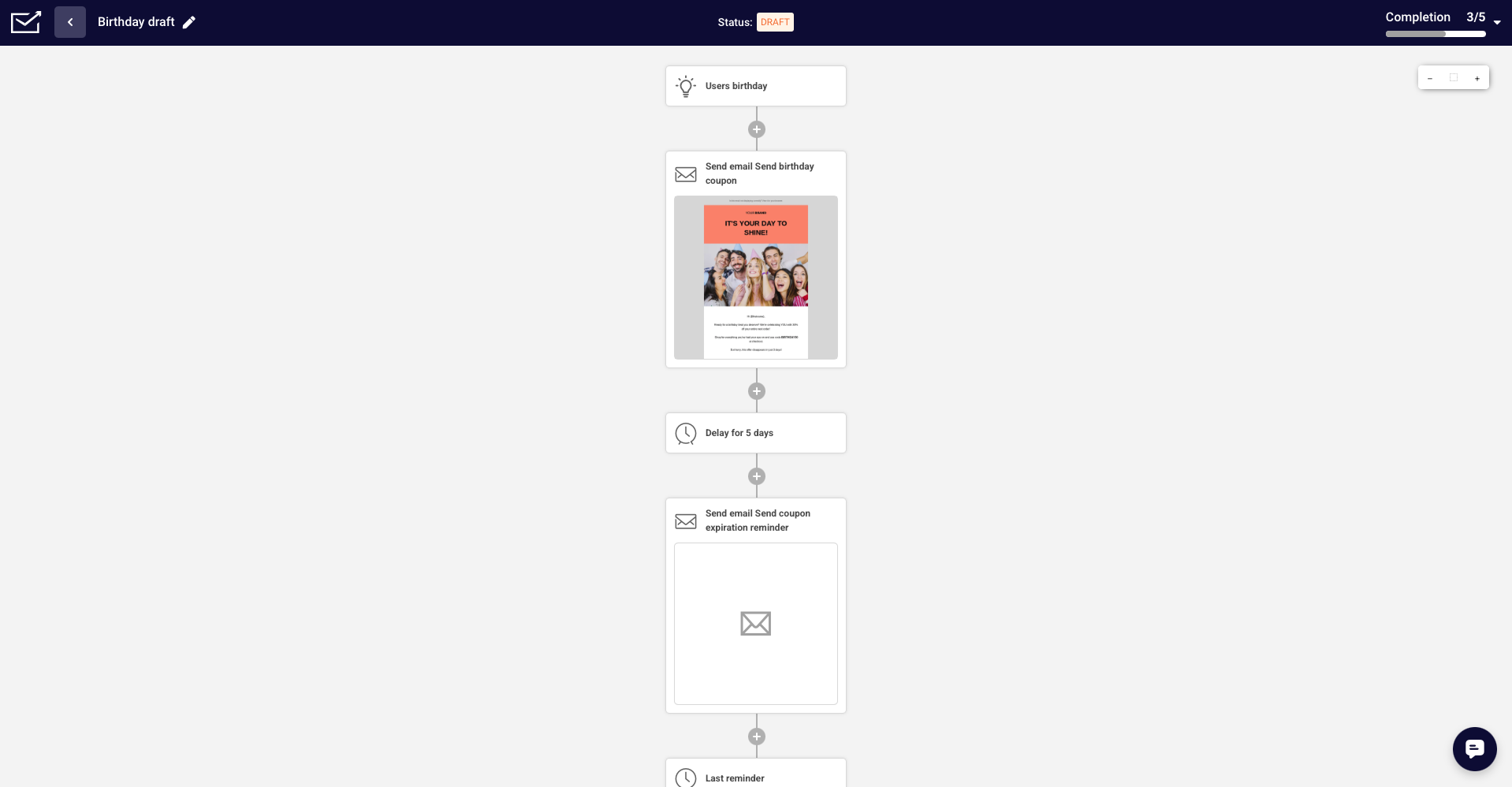
Birthday email workflows should trigger close to or on the actual birthday. Our rule of thumb is that you should kickstart a birthday campaign at least 14 days before the special day, which should give you enough time to automate and set up a coordinated 3-4 email campaign.
- Data collection strategy. Gather birth dates through account creation processes, post-purchase surveys, preference centers, or loyalty program registrations. Incentivize data sharing by explaining how it enables you to deliver personalized experiences and exclusive benefits.
- Design considerations. Create visually appealing templates with festive elements, personalized greetings, and celebration imagery that reinforce the special occasion. Maintain brand consistency while incorporating birthday-specific design elements that create emotional resonance.
- Offer strategy. Provide meaningful incentives like percentage discounts, free shipping, bonus loyalty points, or exclusive product access. Consider extending offers for full weeks to accommodate different shopping preferences and increase redemption opportunities.
7. Gather Feedback Workflow
Feedback collection automation is a simple way to hear what your customers really think. Not only does this make your products better and your service smoother, but it also makes your business smarter.
Feedback gathering campaigns are triggered following purchase completion, service interactions, or support ticket resolution when experiences remain fresh in customers’ minds.
Trigger: User uses a key feature X times
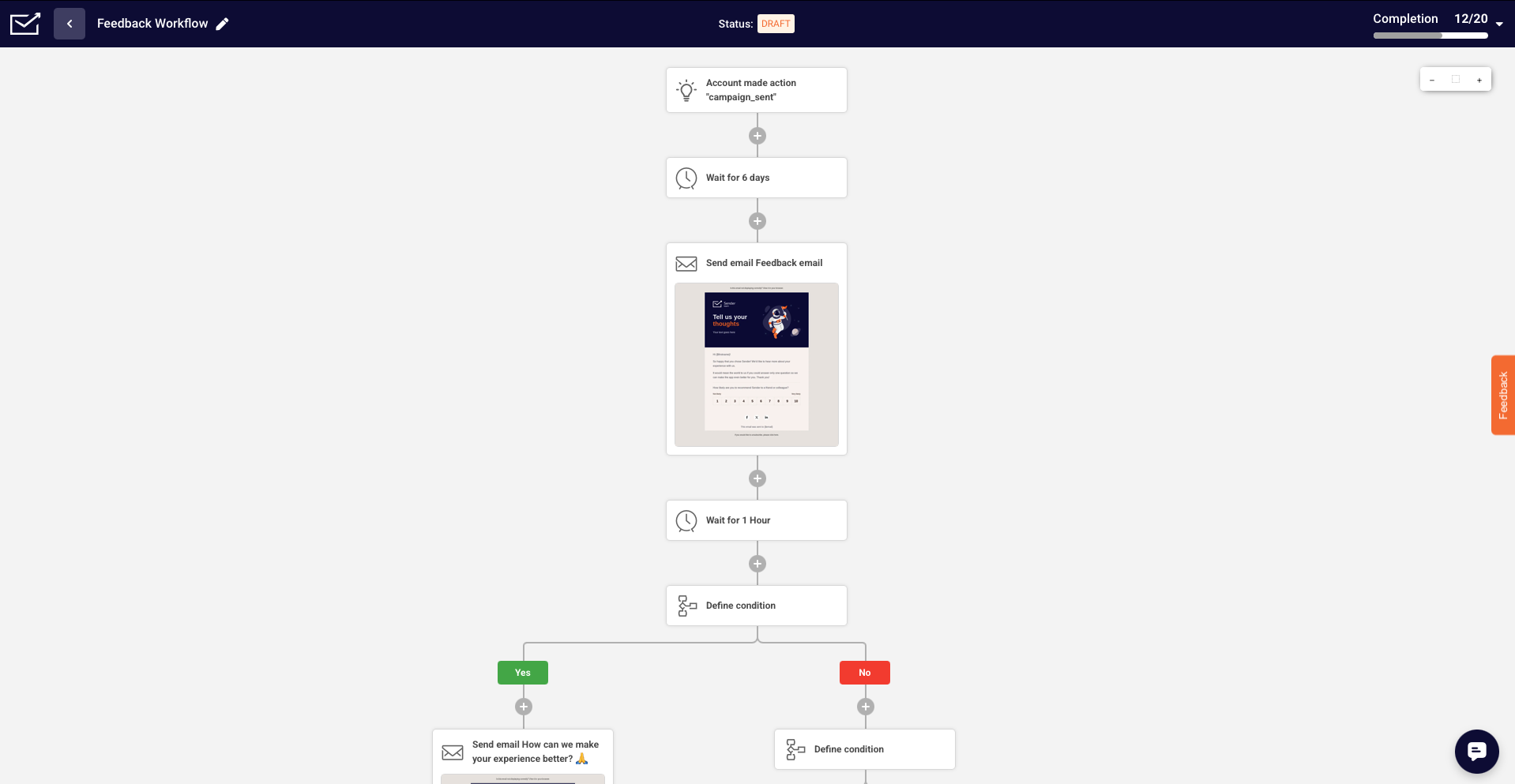
Strategic timing varies by interaction type—survey users’ satisfaction levels immediately after they’re done using your service. However, wait 7-14 days after product purchases to allow adequate trial periods. This approach increases response rates and generates more meaningful, experience-based feedback.
- Survey design. Keep feedback requests concise with 3-5 targeted questions that generate actionable insights. Use rating scales, multiple choice, and open-ended questions strategically to balance quantitative data with qualitative insights.
- Incentive strategy. Offer modest incentives like discount codes, loyalty points, or contest entries to improve response rates without biasing feedback quality. Communicate how customer input influences business decisions and product development.
- Follow-up actions. Send thank-you messages acknowledging participation to demonstrate how feedback creates improvements. Share product updates, service enhancements, or policy changes that resulted from customer suggestions.
8. Product Review Workflow
Review generation workflows encourage satisfied customers to share experiences while creating authentic social proof that influences future purchase decisions. These strategic sequences boost SEO rankings, increase conversion rates, not to mention build credibility through genuine customer testimonials.
Product review campaigns should trigger after delivery confirmation or predetermined post-purchase timeframes, typically within 7-14 days to allow adequate product trial and experience formation.
Trigger: Order fulfilled or delivered X days ago
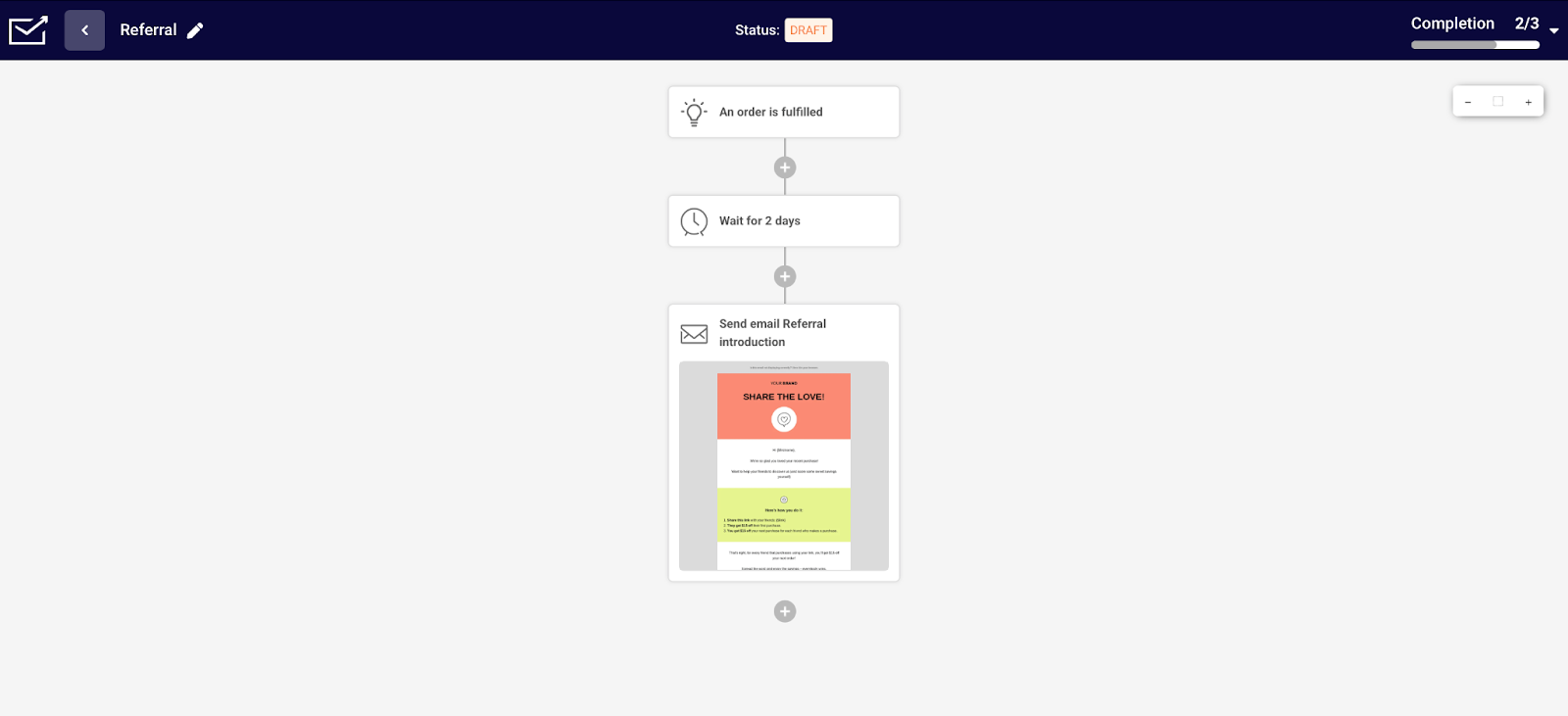
The 2-3 email sequence starts with gentle review requests emphasizing customer voice importance, progresses to incentivized appeals offering small rewards, and concludes with easy unsubscribe options for non-responders to maintain positive relationships and a healthy deliverability rate.
- Platform Strategy. Direct customers to preferred review platforms like Google, Yelp, Amazon, or industry-specific sites based on business goals and customer preferences. Provide direct links and simplified review processes to minimize friction.
- Incentive Balance. Reward customer loyalty and time with points, small discounts, or contest entries that encourage participation without appearing to purchase positive reviews. Maintain ethical standards while motivating customer action.
- Review Management. Monitor generated reviews across platforms and respond professionally to both positive and negative feedback. Use review insights for product improvements and customer service enhancements.
- Content Amplification. Leverage positive reviews in marketing materials, website testimonials, social media posts, and future email campaigns to maximize social proof impact and build brand credibility with prospects.
9. Webinar Registration Follow-up
Webinar automation workflows help boost attendance by keeping registrants informed, engaged, and excited before the big day. With smart, automated prep, you can turn a simple sign-up into a steady stream of anticipation that drives more people to actually show up.
Registration follow-up should trigger as soon as someone registers for the event, starting with a confirmation email that thanks them, confirms their spot, and includes a one-click “Add to Calendar” link so they don’t forget.
Trigger: User completes registration for a webinar
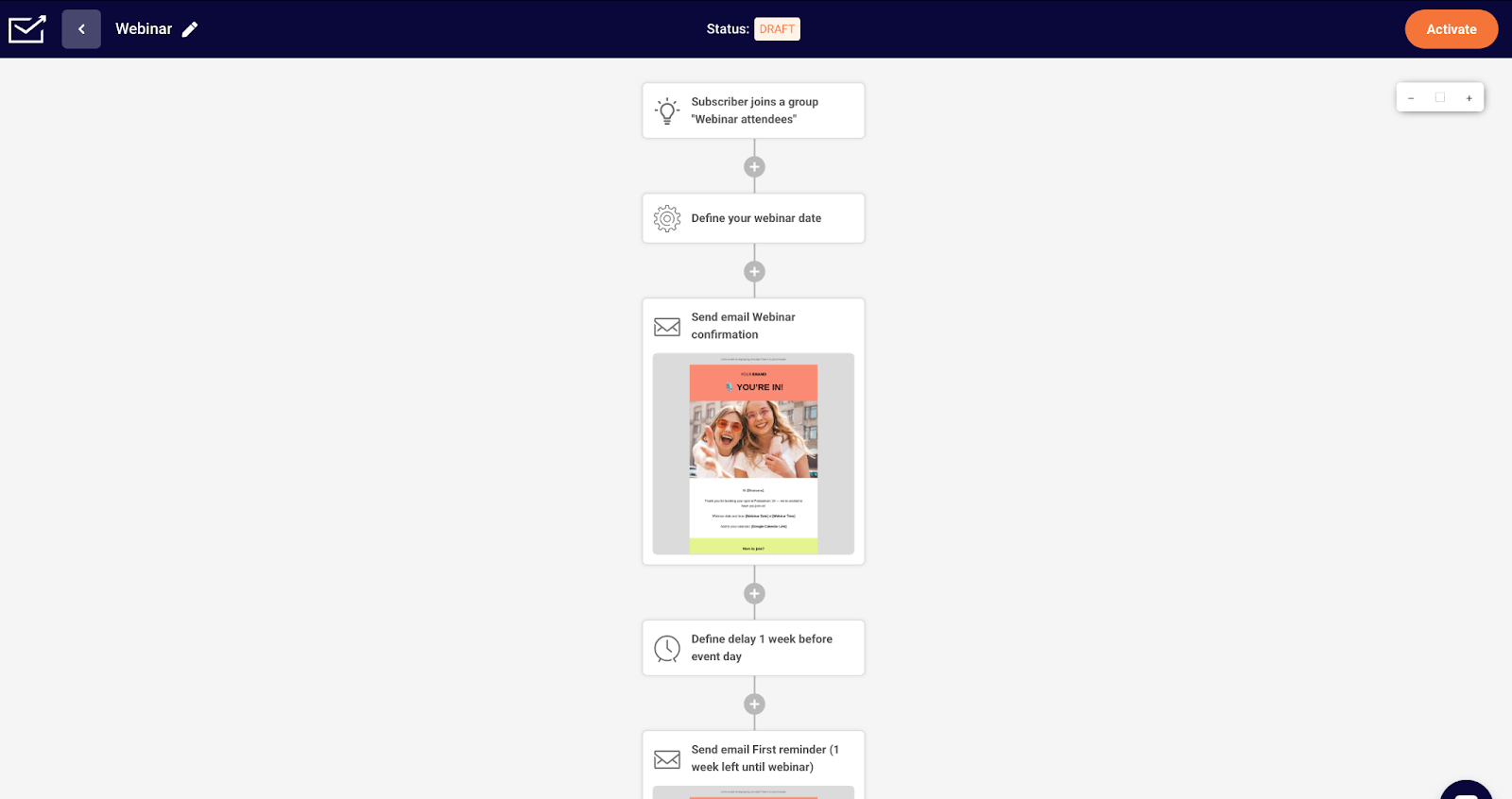
Pre-webinar sequences include immediate confirmation emails with calendar integration, preparatory content like agenda previews or related resources, and strategic reminders 24 hours and 1 hour before session start times to maximize attendance rates.
- Content Strategy. Provide value before, during, and after webinars through preparation materials, interactive elements, downloadable resources, and exclusive follow-up content that extends learning beyond the session timeframe.
- Segmented Follow-Up. Create different post-webinar sequences for attendees versus non-attendees. Attendees receive recording access, additional resources, and consultation opportunities, while non-attendees get recording access with compelling reasons to attend future sessions.
- Lead Qualification. Use webinar engagement data, including attendance duration, chat participation, and poll responses for lead scoring and sales qualification. Provide sales teams with detailed engagement insights for personalized follow-up conversations.
- Event Series Integration. Connect individual webinar workflows with broader educational campaign sequences, encouraging registration for related events and building comprehensive learning paths that establish thought leadership.
10. Onboarding Sequence Workflow
Not to be confused with welcome campaigns, customer onboarding workflows help new users get up to speed fast and see the value in what you offer right away. With a clear, friendly process and proactive support, you make it easier for them to stick around and keep using your product.
These campaigns should be triggered right after signup completion, service purchase confirmation, or subscription activation.
Trigger: User completes signup
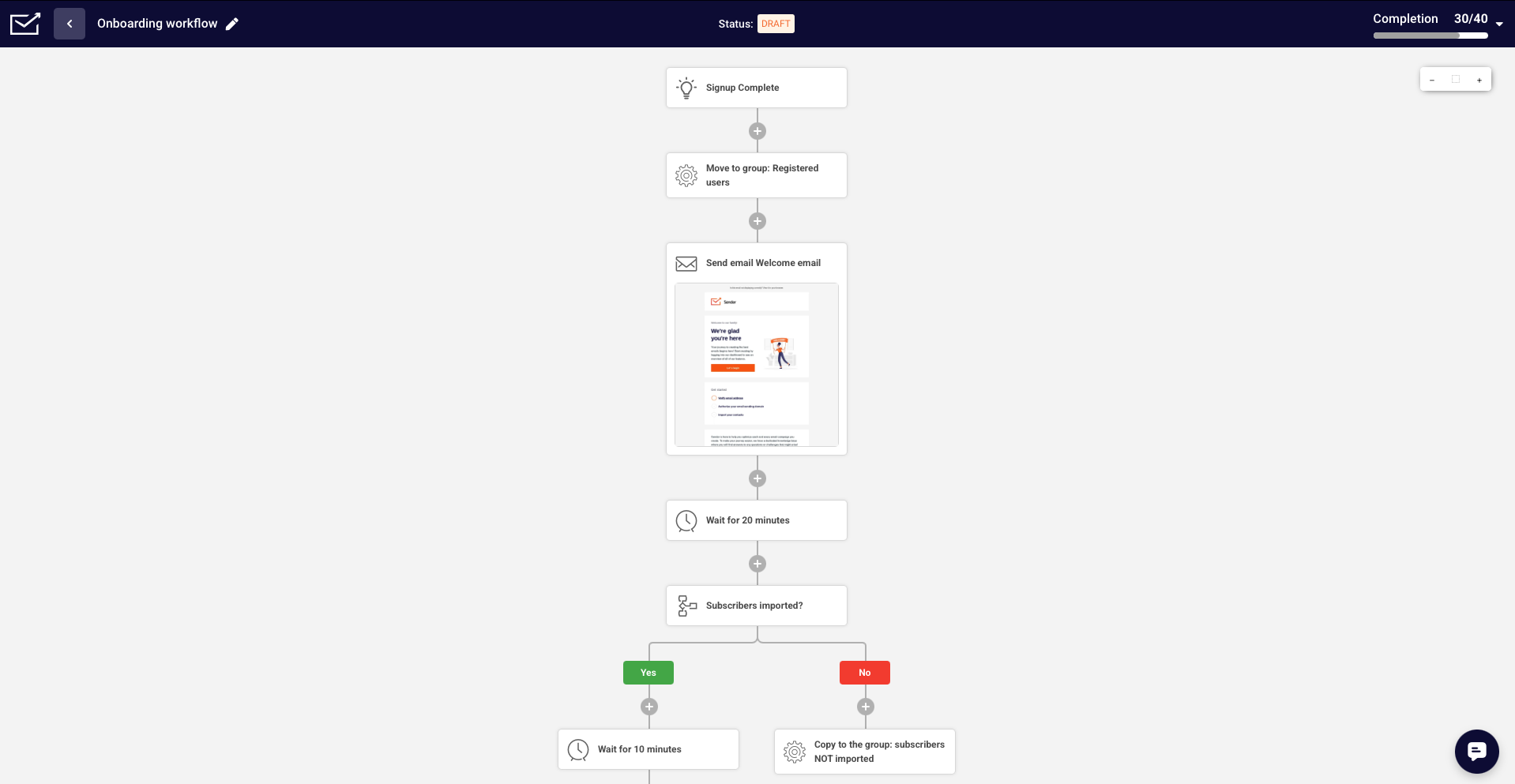
The multi-week sequence provides step-by-step guidance through setup processes, highlights key features through tutorials and walkthroughs, and delivers training resources that build user competency and confidence gradually.
- Progressive Disclosure. Avoid overwhelming new users by spacing content delivery across several days or weeks, introducing features gradually based on usage patterns and comfort levels. Monitor engagement to adjust pacing appropriately.
- Multi-Format Training. Include diverse educational content like video tutorials, written guides, interactive demos, and live training sessions to accommodate different learning preferences and technical skill levels.
- Success Metrics. Track completion rates for various onboarding steps, time-to-first-value achievement, and early engagement patterns to identify optimization opportunities and potential churn risks requiring intervention.
- Support Integration. Provide multiple assistance channels, including live chat, help documentation, community forums, and dedicated onboarding specialists to address questions and obstacles that might impede progress.
11. Cross-sell/Upsell Workflow
Revenue optimization workflows boost customer lifetime value by suggesting relevant add-ons or upgrades tailored to existing customers’ past purchases, browsing habits, and predicted needs. With smart timing and personalized recommendations, they grow revenue while keeping customers happy.
Upselling campaigns should trigger after purchase completion, specific product category browsing, spending threshold achievement, or anniversary dates, ensuring recommendations align with customer readiness and interest.
Trigger: User consistently active and engaged for X days, indicating readiness for more advanced features
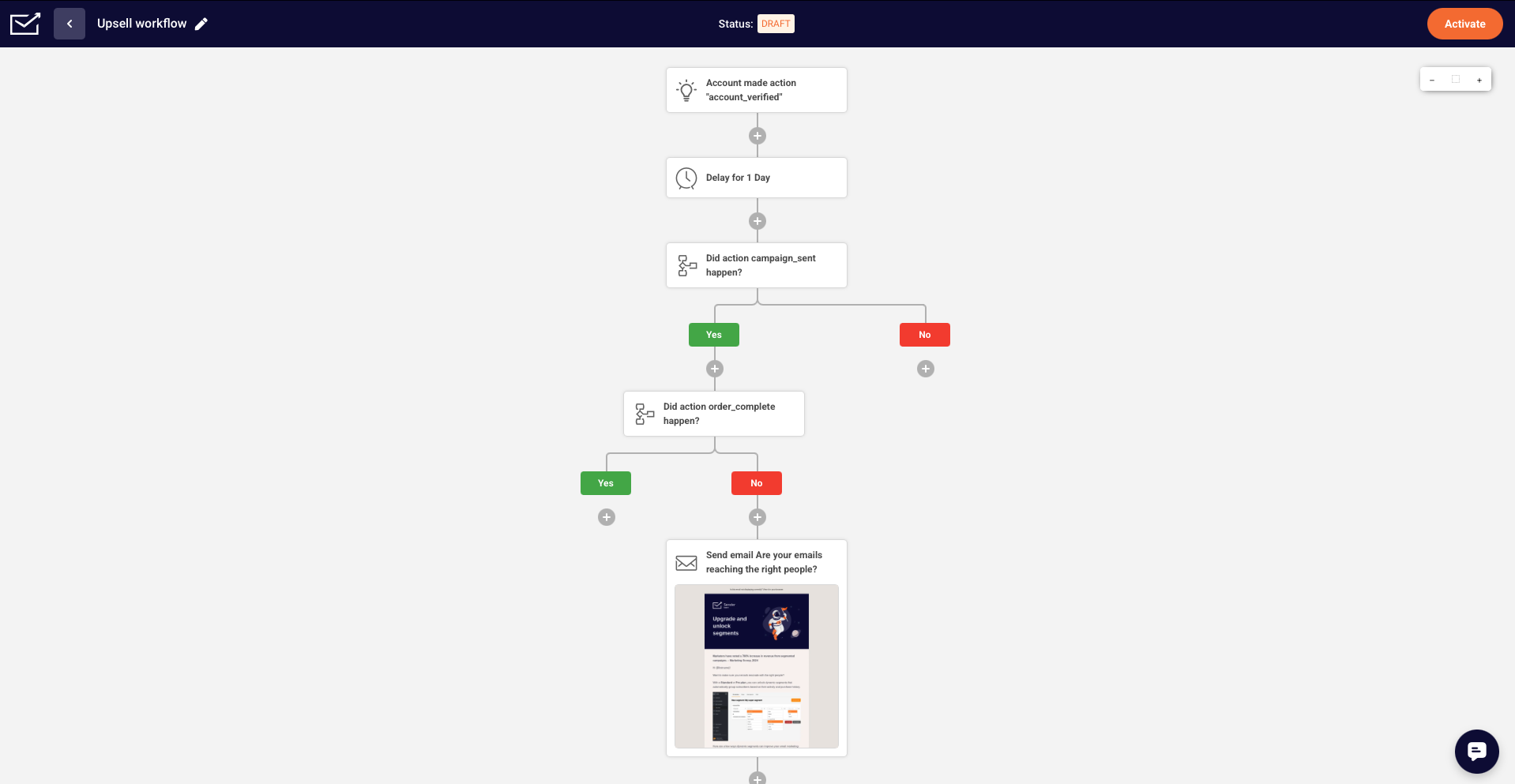
One thing to keep in mind is that strategic timing is different for cross-selling and upselling. Promote complementary products immediately after initial purchases. Meanwhile, you should wait 30-60 days for upgrade suggestions to allow satisfaction establishment with current products.
- Recommendation Engine. Leverage purchase history analysis, collaborative filtering, and customer data to suggest products that genuinely enhance customer experiences rather than simply increasing transaction values.
- Social Proof Integration. Include “customers who bought X also purchased Y” messaging, customer reviews, and usage statistics to build confidence in recommendations and address potential purchase hesitations.
- Bundle Strategy. Create attractive product combinations with preferential pricing that encourages multiple purchases while providing clear value propositions that justify additional spending.
- Segmentation Approach. Customize recommendations based on customer value segments, purchase frequency, and engagement levels to ensure messaging appropriateness and maximize conversion potential.
12. Price Drop & Back-in-Stock Alert Workflow
Price drop and back-in-stock workflows are powerful marketing automation campaigns designed to re-ignite interest from customers who previously viewed, saved, or attempted to purchase products that were either out of stock or priced higher at the time.
These workflows consistently deliver some of the highest conversion rates in ecommerce because they target warm audiences with high purchase intent. Customers who receive restock or price-reduction notifications convert at 3–5x* higher rates than regular promotional emails.
Trigger: User expresses interest in a product (views, saves, subscribes to alerts) and the item either drops in price or comes back in stock.
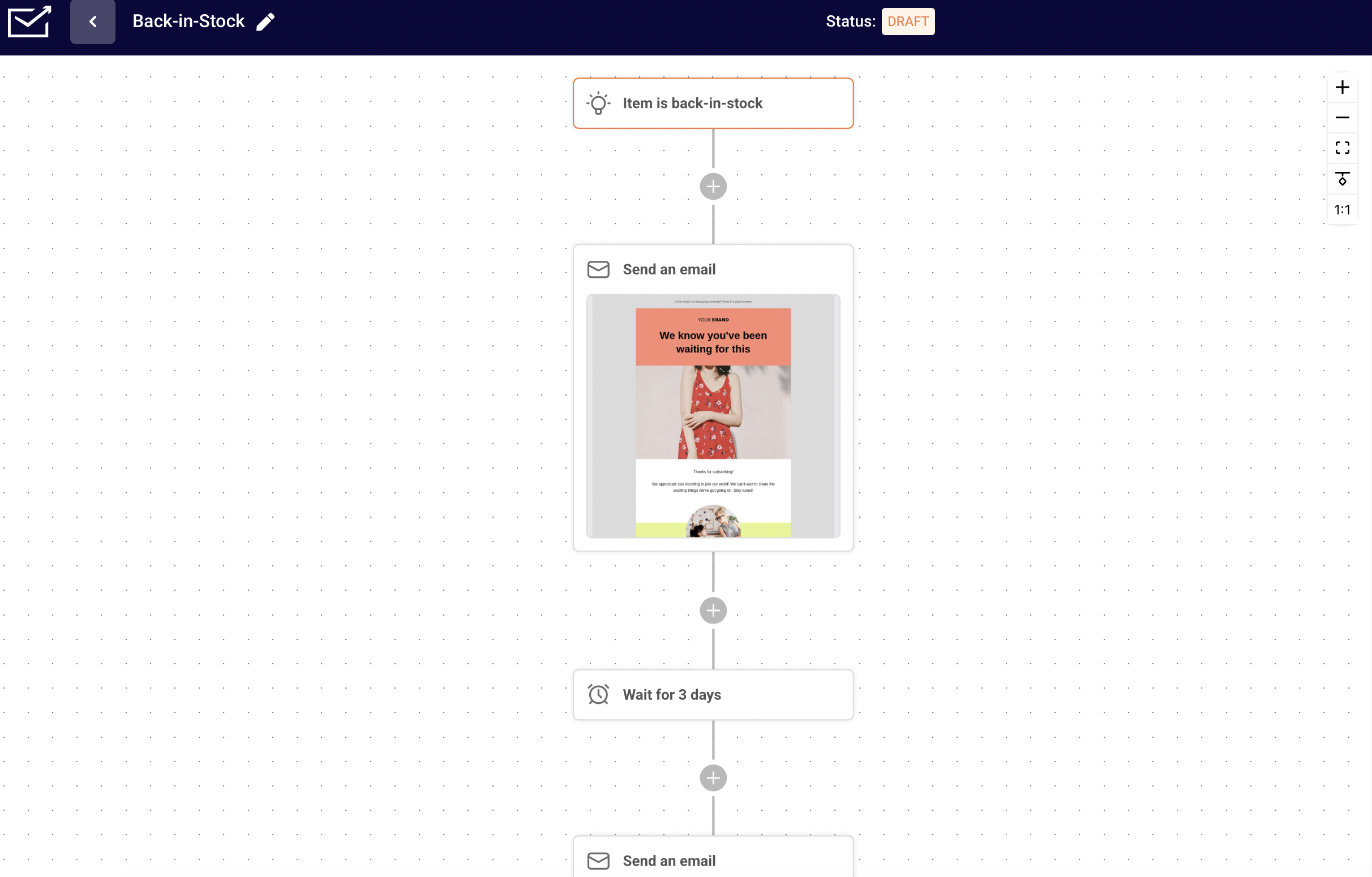
Price drop and inventory-based workflows activate when prices fall below a set threshold, stock levels update from zero to available, or new inventory arrives for previously sold-out items. Automated systems monitor product catalog changes in real time, sending alerts within minutes of the update to maintain urgency and minimize lost sales opportunities.
- Urgency & Timing. Send the initial alert immediately when the condition is met. For restocks, follow with a reminder after 6–12 hours, especially if inventory is limited. For price drops, schedule a second reminder before the offer expires or when the promo stock becomes low;
- Cross-Sell Opportunities. Suggest related products or accessories in case the customer decides against the original item. This is especially effective for back-in-stock alerts—use AI-driven recommendations or bundles to increase average order value;
- Channel Diversification. Boost results by sending alerts across multiple channels. Pair email with SMS, push notifications, or in-app messages to ensure high real-time visibility—especially for fast-moving or limited-edition items;
- Performance Optimization. Track conversion rates, alert-to-purchase time, stock-out speed, and engagement metrics. A/B test subject lines focusing on urgency (“Back in Stock!”), exclusivity (“You’re the first to know”), or savings (“Price Just Dropped”). Monitor inventory forecasting to avoid alerting users about items that will sell out too quickly, leading to frustration.
13. Lead Scoring & Qualification Workflow
Lead scoring and qualification workflows help marketing and sales teams focus their efforts on the prospects most likely to convert. Instead of guessing which leads deserve attention, automated scoring systems evaluate each prospect’s actions, behaviors, and demographics—turning engagement data into clear indicators of buying intent.
This workflow is essential for businesses with long or complex sales cycles, as it eliminates manual lead prioritization and ensures sales teams receive warm, well-informed, and sales-ready prospects. Companies using automated or AI-driven lead scoring report up to 40%* higher conversion rates and significantly shorter sales cycles.
Trigger: Lead performs key high-value actions (e.g., downloads resource, visits pricing page, attends webinar, submits interest form, or reaches a scoring threshold).

Lead scoring workflows activate when users accumulate enough engagement points to signal meaningful interest. These points are assigned automatically based on behavior—like email clicks, repeated website visits, webinar participation—as well as firmographic or demographic data such as job role, company size, or industry.
- Scoring Model Strategy. Assign weighted points to different behaviors depending on intent level. High-value activities (e.g., request a demo, add billing info, engage with pricing pages) earn more points. Medium-value actions (e.g. blog readings, email clicks) and low-value interactions (e.g., homepage visits) help build a complete engagement profile. Negative scoring can also be applied for inactivity or irrelevant behaviors;
- Qualification Thresholds. Establish clear score benchmarks for segment transitions such as MQL (Marketing Qualified Lead), SQL (Sales Qualified Lead), or PQL (Product Qualified Lead). Once a lead surpasses a threshold, the system should automatically route them into the next workflow stage—such as sales outreach, nurturing sequences, or product demos;
- Automated Sales Handoff. Once a lead becomes sales-ready, notify your sales team instantly with a detailed activity log including visited pages, content consumed, previous interactions, and engagement history. This equips sales reps with context-rich information, enabling personalized and timely outreach;
- Dynamic Segmentation. As leads accumulate points, automation tools can move them into new audience segments. For example, highly active leads may receive deadline-driven offers, while moderately engaged leads continue through nurturing sequences. This ensures communications match the lead’s intent and stage in the funnel.
Common Marketing Automation Workflow Mistakes to Avoid
Even the most powerful marketing automation processes can underperform if they’re not set up correctly. Avoiding these common mistakes helps ensure your campaigns stay relevant, efficient, and most importantly—not overwhelm your audience or waste valuable marketing resources.
1. Over-Automating Without Personalization
- Sending generic, automated messages weakens engagement and makes your brand feel robotic rather than helpful. For instance, 1 in 2 customers* will look elsewhere for the same product if they receive an email that’s not personalized;
- Tailor workflows with behavioral triggers, past interactions, and dynamic content to maintain strong relevance;
- Blend automation with a human tone to keep communications warm and value-focused. If you don’t have a dedicated copywriter on hand, let your friends/colleagues read the email for that final generic-proof check before sending it.
2. Ignoring Workflow Performance Metrics
- Neglecting analytics leads to outdated workflows that no longer match customer behavior or intent;
- Daily check key metrics like open rates, CTR, conversions, and unsubscribe patterns for optimization;
- Use A/B testing to fine-tune subject lines, timing, and content variations for ongoing improvement. If used for campaigns, let your split test ‘cook’ for 24-48 hours before diving into data.
3. Poor Audience Segmentation
- Bulk emailing reduces engagement and increases friction because customers receive irrelevant content. Studies show that compared to broad messaging, personalized emails deliver 6x higher transaction rates, 29% higher open rates, and 41%* higher click-through rates;
- Segment users by behavior, demographics, purchase history, or lifecycle stage for higher relevance. Segmented email campaigns can drive 30% more opens and 50%* more click-throughs than non-segmented ones;
- Refresh and refine segments regularly to keep pace with changing customer intent or interests.
4. Setting Unrealistic Triggers or Timing
- Spamming emails can lead to unsubscribes. Around 51%* of users claim that being spammed with emails leads them to unsubscribing;
- Orchestrate communications strategically based on natural user behavior and buying cycles;
- Ensure workflow triggers represent meaningful actions that actually signal intent, not minor interactions. Those can be putting something in a shopping cart and forgetting about it or hitting a milestone in their customer journey.
5. Failing to Test Before Launching
- Un-tested workflows risk sending broken links, incorrect messages, or mis-timed emails. Before hitting ‘Send’, take a moment to carefully go through the entire email—on multiple devices—to prevent sending a colossal reputation-damaging failure;
- Test, test & test. Do that with each branch, trigger, conditional rule, and send time before going live;
- Double-check personalization fields and dynamic content to avoid embarrassing errors or mismatches.
6. Forgetting about Exit Conditions
- Without exit rules, users may stay stuck in automated workflows and receive repetitive or irrelevant messages. That may not sound like such a bad thing to you, but for your contacts—that may as well be a marketing hell;
- Define exits for conversions, inactivity, or movement into higher-priority sequences;
- Avoid overlap by establishing workflow hierarchy and suppression rules across campaigns.
Creating Marketing Automation Workflow
In order to build marketing automation workflows you need a thought-out plan and the right tools. Modern email marketing platforms provide drag-and-drop workflow builders that make creating customer journey automation accessible to marketers without technical expertise.
When selecting a workflow automation platform, prioritize solutions that offer visual workflow builders, comprehensive integration capabilities, and advanced segmentation features. One such platform is Sender, which offers 9 ready-to-use workflow templates for building automated marketing campaigns, including abandoned cart recovery, welcome and giveaway automations.
As soon as you open up Sender’s dashboard, enter the ‘Automation’ section, then click on the ‘Create new workflow’ button—the rest is up to your imagination! Plus, its advanced personalization tools ensure your campaigns always feel relevant and not too market-y, making it one of the best newsletter software on the market.
Sources:
- https://nucleusresearch.com/research/single/marketing-automation-returns-5-44-for-every-dollar-spent/
- https://www.invespcro.com/blog/lead-nurturing/
- https://www.experianplc.com/newsroom/press-releases/2014/experian-marketing-services-study-finds-personalized-emails-generate-six
- https://www.oberlo.com/blog/email-marketing-statistics
- https://www.statista.com/statistics/477804/online-shopping-cart-abandonment-rate-worldwide/
- https://store.orderlyemails.com/blogs/blog/cart-abandonment-emails-your-second-chance-at-the-sale
- https://mailtrap.io/blog/confirmation-emails/
- https://www.omnisend.com/blog/birthday-emails-tips-and-best-practices/
- https://unbounce.com/email-marketing/email-conversion-rate
- https://growleads.io/blog/how-ai-driven-lead-scoring-increases-b2b-conversion-rates/
- https://www.socialmediatoday.com/news/13-surprising-email-personalization-statistics-infographic/528246/
- https://www.experianplc.com/newsroom/press-releases/2014/experian-marketing-services-study-finds-personalized-emails-generate-six
- https://www.hubspot.com/state-of-marketing
- https://blog.hubspot.com/marketing/why-consumers-subscribe-to-email

